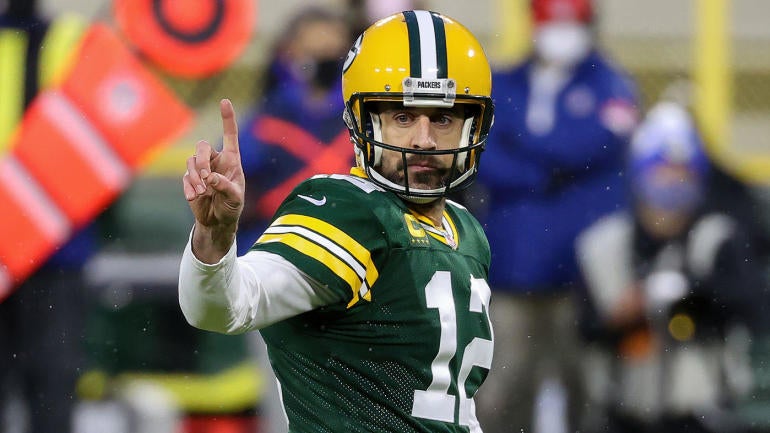
The NFL and NFLPA agreed on June 22 to amend the adjustments to the 2020 collective bargaining agreement made last year because of the COVID-19 pandemic. Players have until Friday (July 2) at 4 p.m. eastern to opt out of the 2021 season by giving written notice their teams.
These rules have given quarterback Aaron Rodgers a nuclear option in his well-publicized rift with the Packers that would be more advantageous to him financially than holding out or retiring .The biggest drawback to Rodgers opting out of the 2021 season voluntarily is the decision is irrevocable and final. This means Rodgers couldn't decide to play later in the season after voluntary opting out, whereas he could still play in 2021 by ending a hold out or retirement.
Financial cost
Rodgers wouldn't be subject to a mandatory $50,000 fine for each day of training camp missed by opting out. For fining purposes under the CBA, training camp runs from the mandatory reporting date (July 27 for Green Bay) through the Sunday before the first regular-season game (Sept. 5). Skipping Green Bay's entire training camp in a holdout would cost Rodgers $2.05 million.
The Packers would also have the right to start recovering a portion of the $57.5 million signing bonus Rodgers received in his 2018 contract extension with a training camp holdout and the $6.8 million roster bonus he earned in March. Recoupment would be at Green Bay's discretion.
The maximum of signing bonus a team can recover in a season is the entire prorated amount for the player in that contract year, which is $11.5 million in Rodgers' case. The Packers only have rights to the roster bonus because he would be breaching his contract in the same year this money is being earned. Because of this, the Packers aren't allowed to recapture any of Rodgers' roster bonuses from 2018, 2019 and 2020. Maximum recoupment amount for 2021 is determined by dividing the $6.8 million by Rodgers' three remaining contract years, which is $2,266,666. Rodgers would have to withhold his services a significant portion of the regular season for these maximum amounts to be reached.
Retirement, which would be a more expensive proposition, is reportedly an option for Rodgers, although he has previously stated on several occasions he plans on playing into his 40s. If Rodgers never returned to the NFL, the Packers would be entitled to the remaining $23 million of signing bonus proration in his 2021 and 2022 contract years as well as the $6.8 million roster bonus for a total of $29.8 million
Green Bay wouldn't be allowed to recoup any of Rodgers' signing bonus with him opting out. The $6.8 million roster bonus, which is scheduled to be paid in equal installments for a 36-week period once the regular season begins, would also be off-limits for the Packers this year.
The Packers would still be obligated to pay Rodgers this bonus. In all of these cases, Rodgers wouldn't earn any of his $14.7 million base salary for this year.
By opting out, Rodgers would make $6.8 million thanks to the roster bonus. A lengthy holdout would cost Rodgers $15,816,666 if Green Bay exercised its rights to the fullest extent with recoupment and he complied through payment. The difference in the two approaches, opting out versus a holdout, is $22,616,666.

Pick Six Newsletter
Crafted By The Best NFL Experts
Get the day's big stories + fun stuff you love like mock drafts, picks and power rankings.
Thanks for signing up!
Keep an eye on your inbox.
Sorry!
There was an error processing your subscription.
Salary cap ramifications
Rodgers' contract would toll for the season by opting out. Essentially, his contract would be frozen and resume in 2022 with tolling. Rodgers' 2021 contract year would become his 2022 contract year and additional years in the contract also would get pushed back one year. He is currently under contract through the 2023 season. Rodgers' contract would expire after the 2024 season instead if tolling occurred.
There would be significant favorable salary cap consequences for Green Bay with Rodgers opting out. His remaining 2021 compensation and 2021 bonus proration would be removed from Green's Bay 2021 salary cap. The 2021 bonus proration would also shift to 2022 with the rest of the 2021 contract year.
Rodgers' total compensation in 2021 is $22 million on a $37.202 million salary cap number. The $22 million consists of a $14.7 million base salary, the $6.8 million roster bonus and a $500,000 workout bonus that wasn't earned because of lack of participation in the offseason workout program. The other $15.202 million making up Rodgers' cap number is the $11.5 million of signing bonus proration from the 2018 extension, $2.852 million of signing bonus proration from a 2019 contract restructure for cap purposes and $850,000 in incentives classified as likely to be earned.
Rodgers' $14.7 million base salary, the unearned $500,000 workout bonus, $850,000 in likely-to-be-earned incentives and $14.352 million of bonus proration would come off Green Bay's books for this year. Only the $6.8 million from the roster bonus would remain as a cap charge. The Packers would pick up $30.402 million of 2021 salary cap room because of Rodgers opting out and his contract tolling.
The $30.402 million in unexpected 2021 cap room would really come in handy for Green Bay since unused cap space can be carried over from one year to the next. The Packers have the NFL's most challenging salary cap situation for 2022. They have a league-high $237.75 million in 2022 cap commitments with 50 players under contract, according to NFLPA data while the top 51 salaries (i.e.; cap numbers) matter with offseason salary cap accounting rules. A salary cap ceiling of $208.2 million was recently set by the NFL and NFLPA. Some of the salary cap windfall could be allocated to an extension for All-Pro wide receiver Davante Adams or the $20.12 million it will cost to designate him as a nonexclusive franchise player in 2022 should his contract expire.
Rodgers' existing 2022 cap number is $39.852. Since Rodgers' 2021 contract year would become his 2022 contract year with tolling, his 2022 cap number would be $30.402 million. Green Bay would pick up an additional $9.45 million of 2022 cap space this way. Green Bay's combined cap swing through tolling would be $39.852 million. Although Rodgers would have already received payment of the $6.8 million roster bonus and it wouldn't be part of the 2022 cap number, the Packers would have recovery rights with a contract breach occurring next year.
Jordan Love factor
The Packers traded up to the 26th overall pick last year to take Love as Rodgers' potential successor at quarterback. The future would become now if Rodgers opted out. Love showing signs of living up to the potential that made him a first-round pick would make Rodgers expendable through a trade in 2022.
The Packers would have a $31.556 million cap charge from the remaining proration of his $57.5 million signing bonus and the $14.26 million converted into signing bonus during the 2019 contract restructure with a 2022 trade of Rodgers in a conventional time frame next March when the league year begins. This would be a $1.154 million increase to Green Bay's salary cap since Rodgers' 2022 cap number after opting out would be $30.402 million.
Although it would be extremely beneficial for Green Bay cap-wise to trade Rodgers after June 2 or agree to trade him beforehand becoming effective on June 2, any draft capital obtained for him would come in 2023 under this scenario. Trading Rodgers before next year's NFL Draft would be a necessity if Green Bay wanted 2022 draft picks to move him.
A poor 2021 season by Love, which would most likely result in Green Bay missing the playoffs, could provide an avenue for Rodgers to finish his career in Green Bay. The jobs of president and CEO Mark Murphy and/or general manager Brian Gutekunst, who are reportedly a primary source of Rodgers' discontent, could be in jeopardy under those circumstances.
Final thoughts
Rodgers punting on the 2021 season through opting out would be a major surprise. The earliest a resolution will occur with Rodgers' situation will most likely come near the end of July as the start of training camp is approaching. If not, Rodgers and the Packers will be engaged in a high-stakes game of chicken with each side waiting for the other to blink first.
















